 |
 |
|
 |
|
 |
|  |
|  |
|
 |
From: Jörg 'Yadgar' Bleimann
Subject: Re: Probably I'm just in fact too stupid...
Date: 26 Nov 2009 17:38:40
Message: <4b0f0370@news.povray.org>
|
|
 |
|  |
|  |
|
 |
High!
Alain wrote:
> You have TWO (2) medias. An emissive one and a scattering one.
Now I removed the emissive media...
> You did NOT reduce the density of your scattering media, and that is
> your problem.
After I adapted the scattering media density reciprocally to the scale
(i. e. 1/36800) I got extremely faint transparent rings - both with and
without absorption 1/36800, see first two images.
When I increased scattering density to 1/368, the rings became more
visible - but still almost black on the unlit side, with some bizarre
geometry showing up on the planet's night side (see third image)!
Could this be an effect of using filter in the color_map?
Here is the code for the last image:
global_settings
{
max_trace_level 10
}
union
{
sphere
{
0, 1
texture
{
pigment { color rgb <0.6, 0.4, 0> }
finish { ambient 0.02 diffuse 1 brilliance 0.8 }
}
}
difference
{
cylinder
{
<0, -0.001, 0>, <0, 0.005, 0>, 3.68
}
cylinder
{
<0, -0.0011, 0>, <0, 0.0011, 0>, 1.75
}
hollow
pigment { rgbt 1 }
interior
{
media
{
// emission 1/36800
scattering
{
5, 1/368
// eccentricity -0.4
// extinction 1
}
// absorption 1/36800
density
{
cylindrical
color_map
{
[0 rgbf <1, 0.8, 0.7, 0.2> ]
[0.1 rgbf <1, 0.8, 0.7, 0.2> ]
[0.1 rgbf <0.1, 0.3, 0.1, 0.5>]
[0.17 rgbf <0.1, 0.3, 0.1, 0.5>]
[0.17 rgbf <0.85, 0.89, 0.94, 0.3>]
[0.18 rgbf <0.85, 0.89, 0.94, 0.3>]
[0.18 rgbf <0.99, 0.93, 0.45, 0.4>]
[0.26 rgbf <0.99, 0.93, 0.45, 0.4>]
[0.26 rgbf <0.5, 0.23, 0.61, 0.5, 0.4>]
[0.36 rgbf <0.5, 0.23, 0.61, 0.5, 0.4>]
[0.36 rgbf <1, 0.92, 0.93, 0.3>]
[0.45 rgbf <1, 0.92, 0.93, 0.3>]
[0.45 rgbf <0, 0, 0, 1>]
}
scale 3.68
}
}
}
}
rotate <2, 7, 0>
scale 10000
translate z*50000
}
light_source
{
<500000, 2500, 5000>
color rgb 1
}
camera
{
location <1.5, 1.5, 0.12>
look_at 1.5
angle 60
}
See you in Khyberspace!
Yadgar
Post a reply to this message
Attachments:
Download '2009-11-25 media test, take 44.jpg' (8 KB)
Download '2009-11-25 media test, take 45.jpg' (8 KB)
Download '2009-11-25 media test, take 46.jpg' (10 KB)
Preview of image '2009-11-25 media test, take 44.jpg'
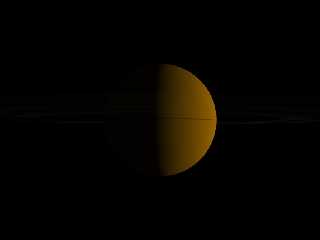
Preview of image '2009-11-25 media test, take 45.jpg'
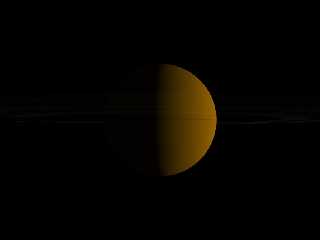
Preview of image '2009-11-25 media test, take 46.jpg'
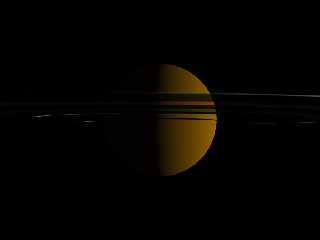
|
 |
|  |
|  |
|
 |
From: Jaime Vives Piqueres
Subject: Re: Probably I'm just in fact too stupid...
Date: 26 Nov 2009 18:15:39
Message: <4b0f0c1b@news.povray.org>
|
|
 |
|  |
|  |
|
 |
> High!
>
> Jaime Vives Piqueres wrote:
>> If you scale UP the container, you have to scale DOWN the media
>> strength! Just try .05 instead 1338181 and you will see the effect...
>> I just tried it and works.
>
> With me, it didn't work at all... still the unlit side is completely
> dark! And when I tried the same combination of scattering and absorption
> on the real Saturn scene, where the rings are about 11 units wide (then
> respectively 1/11 for scattering and absorption strength), the entire
> ring (when viewed upon from the lit side) remains invisible, although
> its shadow is visible on the planet's body!
>
Sorry, I did a poor reading, and for the images I assumed too quickly your
problem was just the ultra-bright media... trying with your code on the last
message, I see that using extinction 0 gives the effect you are looking for.
But I still don't know very well why it doesn't works with the default,
teorically realistic, value of 1.
> watching TV shows instead of overburdening my feeble chicken brain with
> such monstrous tasks like raytracing...
I've a poor brain too, but I discovered it doesn't matters if you have the
power of unlimited "trial&error" at your disposal... ;)
P.S.: You still have the rgbf on the media, which doesn't works as you
think... and you even supplied some of the entries with 5 components colors!
(although it really doesn't matters for your problem).
--
Jaime Vives Piqueres
http://www.ignorancia.org
Post a reply to this message
|
 |
|  |
|  |
|
 |
From: Jörg 'Yadgar' Bleimann
Subject: Re: Probably I'm just in fact too stupid...
Date: 26 Nov 2009 19:11:58
Message: <4b0f194e@news.povray.org>
|
|
 |
|  |
|  |
|
 |
High!
Jaime Vives Piqueres wrote:
> Sorry, I did a poor reading, and for the images I assumed too
quickly your
> problem was just the ultra-bright media... trying with your code on
the last
> message, I see that using extinction 0 gives the effect you are
looking for.
Yes, that's quite logical... I tried it, and it at least yielded roughly
the result I want to achieve in the long run! Thank you for the tip...
perhaps I'll up the extinction value to, let's say, 0.1 or 0.15, as the
unlit side is of course somewhat darker than the lit side, irrespective
of light filtering through...
...but I also found out, that with an exactly reciprocal scattering
strength, the rings become too faint - so I instead made it ten times
stronger (i. e. 1/3680 rather than 1/36800) - see attached images (first
image: unlit side, second image: lit side)!
But, to bring my problem to a "meta level": although I now work more or
less frequently since early 1996 with POV-Ray, I never got much beyond
beginners' skills - since 2000 I keep track of this group, and I've seen
thousands of incredibly sophisticated works (@Jaime Vives Piqueres: for
example your autobahn scene!), and when I compare them to my puny
primitive scenes, I'm close to cry for an euthanasia injection, as I'm
obviously virtually unable to learn from my mistakes... and I HATE
myself for being so dysfunctional!
And I'm really not sure whether having more hobbies than just POV-Ray
(i. e. astronomy, electronic music, Afghanistan...) is the reason... to
me it appears that not so few people who regularly contribute pictures
here have access to, hmmm, time-compressing drugs which allow them to
learn and work 72 hours a day...
See you in Khyberspace!
Yadgar
Post a reply to this message
Attachments:
Download '2009-11-26 media test, take 47.jpg' (13 KB)
Download '2009-11-26 media test, take 48.jpg' (13 KB)
Preview of image '2009-11-26 media test, take 47.jpg'
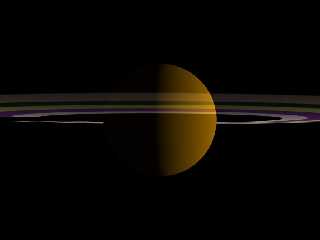
Preview of image '2009-11-26 media test, take 48.jpg'
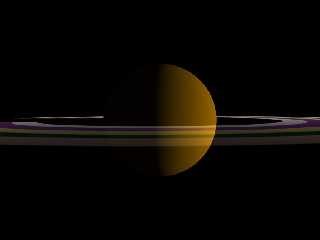
|
 |
|  |
|  |
|
 |
|
 |
|  |
|  |
|
 |
> After I adapted the scattering media density reciprocally to the scale
> (i. e. 1/36800) I got extremely faint transparent rings - both with and
> without absorption 1/36800, see first two images.
>
> When I increased scattering density to 1/368, the rings became more
> visible - but still almost black on the unlit side, with some bizarre
> geometry showing up on the planet's night side (see third image)!
>
> Could this be an effect of using filter in the color_map?
>
Some of the artifacts you are seeing is probably a result of self-shadowing. To
test this, try varying the angle between the rings and sun a little bit, then
test a different extinction value, probably 0.5
You should consider removing the filtering component also, as scattering media
is inherently filtering, and the thickness or brightness comes from the color's
distance from black. Also note that close color control is more easily done by
splitting the single scattering media into a scattering media with no
extinction, and an absorption media that has a different color_map.
The reason for this is that the color scattered is also the color absorbed, and
it can be easier to control the color closely if you scatter the color you wish,
but absorb all colors equally. This can also be done in reverse - scatter all
light (white), but absorb the color opposite of the color you want the media to
be (this may be closer to what happens in real life).
Anyway, here is some code I made from yours. It uses a simple macro to createa
a more complex density that gives the rings from "grain" (that probably wouldn't
be visible from this distance, but looks neat IMHO).
//--------------- beginning of code
global_settings
{
max_trace_level 10
}
#macro wrink(SomeColor, Thickness, ScaleV)
// SomeColor is the color scattered (and absorbed!)
// Thickness defines the ratio of the color supplied as compared to empty
(black)
// ScaleV determines the size of the wrinkle pattern, and therefore the grain
size.
wrinkles
scale ScaleV
color_map{
[0.00 color rgb SomeColor ]
[Thickness color rgb <0,0,0> ]
[1.00 color rgb <0,0,0> ]
}
#end
#declare ShowRings = on;
union
{
sphere
{
0, 1
texture
{
pigment { color rgb <0.6, 0.4, 0> }
finish { ambient 0.00 diffuse 1 brilliance 1 }
}
}
#if( ShowRings )
difference
{
cylinder
{
<0, -0.001, 0>, <0, 0.005, 0>, 3.68
}
cylinder
{
<0, -0.0011, 0>, <0, 0.0011, 0>, 1.75
}
hollow
pigment { rgbt 1 }
interior
{
media
{
//emission 1/500
scattering
{
1, 1/200
extinction 0.5 // 1.00 is also ok
}
density
{
cylindrical
density_map
{
/*
[0.00 rgbf <1.00, 0.80, 0.70, 0.20> ]
[0.10 rgbf <1.00, 0.80, 0.70, 0.20> ]
[0.10 rgbf <0.10, 0.30, 0.10, 0.50> ]
[0.17 rgbf <0.10, 0.30, 0.10, 0.50> ]
[0.17 rgbf <0.85, 0.89, 0.94, 0.30> ]
[0.18 rgbf <0.85, 0.89, 0.94, 0.30> ]
[0.18 rgbf <0.99, 0.93, 0.45, 0.40> ]
[0.26 rgbf <0.99, 0.93, 0.45, 0.40> ]
[0.26 rgbf <0.50, 0.23, 0.61, 0.50> ]
[0.36 rgbf <0.50, 0.23, 0.61, 0.50> ]
[0.36 rgbf <1.00, 0.92, 0.93, 0.30> ]
[0.45 rgbf <1.00, 0.92, 0.93, 0.30> ]
[0.45 rgbf <0.00, 0.00, 0.00, 1.00> ]
*/
[0.00 wrink( <0.00, 0.00, 0.00> * 0.00, 0.5, 10/10000) ]
#local I = 0;
#local MaxI = 200;
#local rs1 = seed(3240);
#while( I < MaxI )
// add bands of lighter and darker rings
#if( !mod(I,12) ) #local RandTrend = rand(rs1); #end
[0.00 + 0.45*I/MaxI
wrink(
<1.00 - 0.20*rand(rs1), 1.00 - 0.10*rand(rs1), 1.00 -
0.05*rand(rs1)> * (0.5 * rand(rs1) + 0.5) * RandTrend,
(0.25 * rand(rs1) + 0.5), (2+rand(rs1)*18)/10000
)
]
#local I = I + 1;
#end
[0.45 wrink( <0.00, 0.00, 0.00> * 0.00, 0, 4/10000) ]
}
scale 3.68
}
}
}
}
#end
rotate <15, 7, 1>
scale 10000
translate z*50000
translate y*-2500
}
light_source
{
<500000, 2500, 5000>
color rgb 1
}
camera
{
location <1.5, 1.5, 0.12>
look_at 1.5
angle 60
}
//--------------- end of code
HTH
-Reactor
P.S. Please be aware that this was rendered using the default gamma settings
under 3.7, and the brightness may vary, necessitating different scattering
settings.
Post a reply to this message
Attachments:
Download 'yagdar_news.bmp.dat' (2305 KB)
|
 |
|  |
|  |
|
 |
|
 |
|  |
|  |
|
 |
Oops! I just realized I posted the bmp, not the png as I'd intended:
-Reactor
Post a reply to this message
Attachments:
Download 'yagdar_news.png' (420 KB)
Preview of image 'yagdar_news.png'
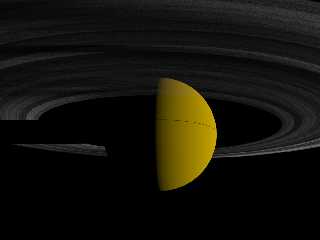
|
 |
|  |
|  |
|
 |
From: Jörg 'Yadgar' Bleimann
Subject: Re: Probably I'm just in fact too stupid...
Date: 26 Nov 2009 19:57:32
Message: <4b0f23fc$1@news.povray.org>
|
|
 |
|  |
|  |
|
 |
High!
Now as I got at least the planet's shadow on the unlit side of the rings
correctly, I wonder how I could have different degrees of transparency
within the rings - like it is with the real Saturn. I tried adding a
second density, now with a density_map instead of a color_map - but the
only thing I observed were different colors, while the transparency
remained uniform across all ring bands.
What is the difference between a color_map and a density_map within a
density statement?
Could I achieve different transparencies by adding an absorption media
with its own density_map? What values of that density map would affect
transparency?
See you in Khyberspace!
Yadgar
Post a reply to this message
|
 |
|  |
|  |
|
 |
|
 |
|  |
|  |
|
 |
=?ISO-8859-1?Q?J=F6rg_=27Yadgar=27_Bleimann?= <yaz### [at] gmx de> wrote:
> High!
>
> Now as I got at least the planet's shadow on the unlit side of the rings
> correctly, I wonder how I could have different degrees of transparency
> within the rings - like it is with the real Saturn. I tried adding a
> second density, now with a density_map instead of a color_map - but the
> only thing I observed were different colors, while the transparency
> remained uniform across all ring bands.
>
> What is the difference between a color_map and a density_map within a
> density statement?
>
> Could I achieve different transparencies by adding an absorption media
> with its own density_map? What values of that density map would affect
> transparency?
>
> See you in Khyberspace!
>
> Yadgar
The second density is very different from a second media - Read the
documentation section on multiple density V.S multiple media.
A density_map is comparable to a pigment_map - it allows density entries within
the map.
The level of transparency is more or less a combination between the distance
from black of the color vector and also the initial color vector for the media
type statement.
example:
emission color rgb <1,1,1>
density{ color rgb 0.01 }
is visually identical to this:
emission color rgb <1,1,1> * 0.01
density{ color rgb 1 }
HTH
-Reactor de> wrote:
> High!
>
> Now as I got at least the planet's shadow on the unlit side of the rings
> correctly, I wonder how I could have different degrees of transparency
> within the rings - like it is with the real Saturn. I tried adding a
> second density, now with a density_map instead of a color_map - but the
> only thing I observed were different colors, while the transparency
> remained uniform across all ring bands.
>
> What is the difference between a color_map and a density_map within a
> density statement?
>
> Could I achieve different transparencies by adding an absorption media
> with its own density_map? What values of that density map would affect
> transparency?
>
> See you in Khyberspace!
>
> Yadgar
The second density is very different from a second media - Read the
documentation section on multiple density V.S multiple media.
A density_map is comparable to a pigment_map - it allows density entries within
the map.
The level of transparency is more or less a combination between the distance
from black of the color vector and also the initial color vector for the media
type statement.
example:
emission color rgb <1,1,1>
density{ color rgb 0.01 }
is visually identical to this:
emission color rgb <1,1,1> * 0.01
density{ color rgb 1 }
HTH
-Reactor
Post a reply to this message
|
 |
|  |
|  |
|
 |
From: Jörg 'Yadgar' Bleimann
Subject: Re: Probably I'm just in fact too stupid...
Date: 26 Nov 2009 20:33:27
Message: <4b0f2c67$1@news.povray.org>
|
|
 |
|  |
|  |
|
 |
High!
Jaime Vives Piqueres wrote:
> Sorry, I did a poor reading, and for the images I assumed too quickly
> your
> problem was just the ultra-bright media... trying with your code on the
> last
> message, I see that using extinction 0 gives the effect you are looking
> for.
> But I still don't know very well why it doesn't works with the default,
> teorically realistic, value of 1.
Yes, it did - but only with the test scene, not with the Saturn scene!
With the latter, when using extinction 0, not even the ring shadow is
visible, let alone the rings, at extinction 0.1 I can at least see the
shadow, but still no rings...
The code? Too long and complicated to be posted here, I fear...
See you in Khyberspace!
Yadgar
Post a reply to this message
|
 |
|  |
|  |
|
 |
From: Jörg 'Yadgar' Bleimann
Subject: Re: Probably I'm just in fact too stupid...
Date: 27 Nov 2009 08:50:25
Message: <4b0fd921@news.povray.org>
|
|
 |
|  |
|  |
|
 |
High!
> The code? Too long and complicated to be posted here, I fear...
(9 hours of sleep later)
O.k., I'll try it:
[...]
#include "starry_sky.inc" // self-programmed macro to generate a starry
sky sphere according to real astronomical data, 900 stars, configurable
according to camera angle and image resolution
#include "functions.inc" // for eval_pigment()
[...]
#declare sc=13347; // 1 POV unit = 13347 kilometres
[...]
#declare rs=0; // radiosity flag, 0 = radiosity off
#declare lores=0; // flag for low resolution Saturnian rings (dependent
on camera distance in the future)
[...]
#declare F_Standard_Planetary_Surface =
finish
{
#if (!rs)
ambient 0.0001
#end
diffuse 1
brilliance 0.8
}
#declare F_Saturn_Rings =
finish
{
#if (!rs)
ambient 0.01
#end
diffuse 1
brilliance 0.05
}
#declare F_Saturn_Rings_UnlitSide =
finish
{
#if (!rs)
ambient 0.3
#end
diffuse 5
brilliance 0.05
}
#declare cam = 7; // camera mode
// CELESTIAL BODIES OF THE SOLAR SYSTEM DATA
// Column 0: orbital semi-major axis (to the Sun or the respective
planet) in kilometres
// Column 1: radius in x dimension, in kilometres
// Column 2: radius in y dimension, in kilometres (if oblateness is
given then stated as -1)
// Column 3: radius in z dimension, in kilometres (if oblateness is
given then stated as -1)
// Column 4: axial tilt in degrees (planets: relative to orbit around
the Sun, moons: relative to planet's equatorial plane)
// Column 5: orbital inclination in degrees (planets: relative to
ecliptic, moons: relative to planet's equatorial plane)
// Column 6: orbital eccentricity
// Column 7: perihelion argument (degrees; if variable (Earth's Moon)
then stated als -1)
// Column 8: longitude of ascending node (degrees; if variable (Earth's
Moon) then stated als -1)
// Column 9: oblateness (not taken into account if different radii
explicitly stated)
// Column 10: declination of north pole (degrees)
// Column 11: right ascension of north pole (degrees!)
// Column 12: albedo (if irrelevant (Sun) stated as -1)
#declare bodies = array [74][12]
{
{ 0, 696000, -1, -1, 7.25, 0,
0, 0, 0, 0.000009, 63.87, 286.125 },
// 0 - Sun
[...]
{ 1433449370, 60268, 54364, 60268, 26.73, 2.484,
0.055723219, 336.013862,113.642811,-1, 83.537, 40.589 } //
72 - Saturn
[...]
}
// PROVISIONAL PLANETARY POSITIONS (to be replaced later according to
astronomically accurate orbital data)
[...]
#declare Pos_Saturn = bodies[72][0]*<sin(radians(157.4)), 0,
cos(radians(157.4))>;
[...]
// CAMERA DATA
#switch(cam)
[...]
#case (7) // centered on Saturn, rings oblique view
#declare camPos = Pos_Saturn + 350000 * <sin(radians(64)), 0,
cos(radians(64))>;
#declare camLook = Pos_Saturn;
#declare camAng = 40;
#break
#case (7.01) // view through Saturn's D ring
#declare camPos = Pos_Saturn + 350000 * <sin(radians(64)), 0,
cos(radians(64))>;
#declare camLook = Pos_Saturn+<10000, -32000, 0>;
#declare camAng = 5;
#break
#case (7.02) // centered on Saturn, view of unlit ring side
#declare camPos = Pos_Saturn + 350000 * <sin(radians(244)), 0,
cos(radians(244))>;
#declare camLook = Pos_Saturn;
#declare camAng = 40;
#break
#end
// CELESTIAL SPHERE
Stars(6, image_width, camAng, 1.5) // invocation of starry sky sphere macro
#macro SetAxis(dec, ras) // macro for orienting planets
rotate <bodies[3][4]-(90-dec), 0, 0>
rotate <0, 90-ras, 0>
#end
light_source // Sun
{
0
color rgb 1
looks_like
{
sphere
{
0, 1
texture
{
pigment { color rgb <1, 1, 0.85> }
finish { ambient 1 diffuse 0 }
}
scale bodies[0][1]/sc
SetAxis(bodies[0][10], bodies[0][11])
}
}
}
[...]
// the following three image files can be obtained at
http://www.mmedia.is/~bjj/data/s_rings/index.html
#declare Saturn_Rings_Colors =
pigment
{
image_map
{
png "solarsys/sat_ring_color_bjoernjonsson.png"
}
}
#declare Saturn_Rings_Transparency =
pigment
{
image_map
{
png "solarsys/transparency_bjoernjonsson.png"
}
}
#declare Saturn_Rings_UnlitSide =
pigment
{
image_map
{
png "solarsys/unlitside_bjoernjonsson.png"
}
}
currently not yet working with media! (but that would be another thread
here!)
#declare Ring_Color_Map_1_to_255 =
color_map
{
#declare a=0;
#while (a<255)
#declare c=eval_pigment(Saturn_Rings_Colors, <2999/3000-a/1500,
0.5, 0>);
#declare f=eval_pigment(Saturn_Rings_Transparency,
<2999/3000-a/1500, 0.5, 0>);
[a*(((140390-74510)/140390)/1500) rgb c filter f.gray]
#declare a=a+1;
#end
}
#declare Ring_Color_Map_256_to_510 =
texture
{
pigment
{
cylindrical
color_map
{
#declare a=255;
#while (a<510)
#declare c=eval_pigment(Saturn_Rings_Colors, <2999/3000-a/1500,
0.5, 0>);
#declare f=eval_pigment(Saturn_Rings_Transparency,
<2999/3000-a/1500, 0.5, 0>);
[a*(((140390-74510)/140390)/1500) rgb c filter f.gray]
#declare a=a+1;
#end
}
}
finish { F_Saturn_Rings }
}
#declare Ring_Color_Map_511_to_765 =
texture
{
pigment
{
cylindrical
color_map
{
#declare a=510;
#while (a<765)
#declare c=eval_pigment(Saturn_Rings_Colors, <2999/3000-a/1500,
0.5, 0>);
#declare f=eval_pigment(Saturn_Rings_Transparency,
<2999/3000-a/1500, 0.5, 0>);
[a*(((140390-74510)/140390)/1500) rgb c filter f.gray]
#declare a=a+1;
#end
}
}
finish { F_Saturn_Rings }
}
#declare Ring_Color_Map_766_to_1020 =
texture
{
pigment
{
cylindrical
color_map
{
#declare a=765;
#while (a<1020)
#declare c=eval_pigment(Saturn_Rings_Colors, <2999/3000-a/1500,
0.5, 0>);
#declare f=eval_pigment(Saturn_Rings_Transparency,
<2999/3000-a/1500, 0.5, 0>);
[a*(((140390-74510)/140390)/1500) rgb c filter f.gray]
#declare a=a+1;
#end
}
}
finish { F_Saturn_Rings }
}
#declare Ring_Color_Map_1021_to_1275 =
texture
{
pigment
{
cylindrical
color_map
{
#declare a=1020;
#while (a<1275)
#declare c=eval_pigment(Saturn_Rings_Colors, <2999/3000-a/1500,
0.5, 0>);
#declare f=eval_pigment(Saturn_Rings_Transparency,
<2999/3000-a/1500, 0.5, 0>);
[a*(((140390-74510)/140390)/1500) rgb c filter f.gray]
#declare a=a+1;
#end
}
}
finish { F_Saturn_Rings }
}
#declare Ring_Color_Map_1276_to_1500 =
texture
{
pigment
{
cylindrical
color_map
{
#declare a=1275;
#while (a<1500)
#declare c=eval_pigment(Saturn_Rings_Colors, <2999/3000-a/1500,
0.5, 0>);
#declare f=eval_pigment(Saturn_Rings_Transparency,
<2999/3000-a/1500, 0.5, 0>);
[a*(((140390-74510)/140390)/1500) rgb c filter f.gray]
#declare a=a+1;
#end
}
}
finish { F_Saturn_Rings }
}
#declare Ring_UnlitSide_Map_1_to_255 =
texture
{
pigment
{
cylindrical
color_map
{
#declare a=0;
#while (a<255)
#declare c=eval_pigment(Saturn_Rings_UnlitSide,
<2999/3000-a/1500, 0.5, 0>);
#declare f=eval_pigment(Saturn_Rings_Transparency,
<2999/3000-a/1500, 0.5, 0>);
[a*(((140390-74510)/140390)/1500) rgb c filter f.gray]
#declare a=a+1;
#end
}
}
finish { F_Saturn_Rings_UnlitSide }
}
#declare Ring_UnlitSide_Map_256_to_510 =
texture
{
pigment
{
cylindrical
color_map
{
#declare a=255;
#while (a<510)
#declare c=eval_pigment(Saturn_Rings_UnlitSide,
<2999/3000-a/1500, 0.5, 0>);
#declare f=eval_pigment(Saturn_Rings_Transparency,
<2999/3000-a/1500, 0.5, 0>);
[a*(((140390-74510)/140390)/1500) rgb c filter f.gray]
#declare a=a+1;
#end
}
}
finish { F_Saturn_Rings_UnlitSide }
}
#declare Ring_UnlitSide_Map_511_to_765 =
texture
{
pigment
{
cylindrical
color_map
{
#declare a=510;
#while (a<765)
#declare c=eval_pigment(Saturn_Rings_UnlitSide,
<2999/3000-a/1500, 0.5, 0>);
#declare f=eval_pigment(Saturn_Rings_Transparency,
<2999/3000-a/1500, 0.5, 0>);
[a*(((140390-74510)/140390)/1500) rgb c filter f.gray]
#declare a=a+1;
#end
}
}
finish { F_Saturn_Rings_UnlitSide }
}
#declare Ring_UnlitSide_Map_766_to_1020 =
texture
{
pigment
{
cylindrical
color_map
{
#declare a=765;
#while (a<1020)
#declare c=eval_pigment(Saturn_Rings_UnlitSide,
<2999/3000-a/1500, 0.5, 0>);
#declare f=eval_pigment(Saturn_Rings_Transparency,
<2999/3000-a/1500, 0.5, 0>);
[a*(((140390-74510)/140390)/1500) rgb c filter f.gray]
#declare a=a+1;
#end
}
}
finish { F_Saturn_Rings_UnlitSide }
}
#declare Ring_UnlitSide_Map_1021_to_1275 =
texture
{
pigment
{
cylindrical
color_map
{
#declare a=1020;
#while (a<1275)
#declare c=eval_pigment(Saturn_Rings_UnlitSide,
<2999/3000-a/1500, 0.5, 0>);
#declare f=eval_pigment(Saturn_Rings_Transparency,
<2999/3000-a/1500, 0.5, 0>);
[a*(((140390-74510)/140390)/1500) rgb c filter f.gray]
#declare a=a+1;
#end
}
}
finish { F_Saturn_Rings_UnlitSide }
}
#declare Ring_UnlitSide_Map_1276_to_1500 =
texture
{
pigment
{
cylindrical
color_map
{
#declare a=1275;
#while (a<1500)
#declare c=eval_pigment(Saturn_Rings_UnlitSide,
<2999/3000-a/1500, 0.5, 0>);
#declare f=eval_pigment(Saturn_Rings_Transparency,
<2999/3000-a/1500, 0.5, 0>);
[a*(((140390-74510)/140390)/1500) rgb c filter f.gray]
#declare a=a+1;
#end
}
}
finish { F_Saturn_Rings_UnlitSide }
}
// the actual planet and rings objects
union
{
sphere // Saturn
{
0, 1
texture
{
pigment
{
image_map
{
jpeg "solarsys/saturn_bjoernjonsson.jpg" // also from
http://www.mmedia.is/~bjj/data/saturn/index.html
map_type 1
interpolate 2
}
}
finish { F_Standard_Planetary_Surface }
}
scale <bodies[72][1], bodies[72][2], bodies[72][3]>/sc
}
difference // rings
{
cylinder
{
<0, -0.11, 0>/sc, <0, 0.1, 0>/sc, 140390/sc
}
cylinder
{
<0, -0.12, 0>/sc, <0, 0.11, 0>/sc, 74510/sc
}
// originally used with the no-media hi-res version of the rings -
I'm currently not sure whether I will able to make use of it also with
media!
/* cylinder // unlit side!
{
<0, -0.15, 0>/sc, <0, -0.1, 0>/sc, 150000/sc
texture
{
cylindrical
texture_map
{
[0 Ring_UnlitSide_Map_1_to_255 ]
[255*(((140390-74510)/140390)/1500) Ring_UnlitSide_Map_256_to_510]
[510*(((140390-74510)/140390)/1500)
Ring_UnlitSide_Map_511_to_765]
[765*(((140390-74510)/140390)/1500)
Ring_UnlitSide_Map_766_to_1020]
[1020*(((140390-74510)/140390)/1500)
Ring_UnlitSide_Map_1021_to_1275]
[1275*(((140390-74510)/140390)/1500)
Ring_UnlitSide_Map_1276_to_1500]
}
scale 140390/sc
}
} */
// ultra-cheap no media version of the rings
#if (lores)
texture // low resolution texture: 255 entries in ring color map
{
pigment
{
cylindrical
color_map
{
#declare a=0;
#while (a<255)
#declare c=eval_pigment(Saturn_Rings_Colors,
<509/510-a/255, 0.5, 0>);
#declare f=eval_pigment(Saturn_Rings_Transparency,
<509/510-a/255, 0.5, 0>);
[a*(((140390-74510)/140390)/255) rgb c filter f.gray]
#declare a=a+1;
#end
}
scale 140390/sc
}
finish { F_Saturn_Rings }
}
#else // current media problem!
hollow
pigment { rgbt 1 }
interior
{
media
{
scattering
{
1, 1
// eccentricity -0.4
extinction 0.1
}
// absorption 0.095
density
{
cylindrical
// hi-res version (1500 color and transparency levels),
currently not usable with media (but please let's discuss this later on!)
/* density_map
{
[0 Ring_Color_Map_1_to_255]
[255*(((140390-74510)/140390)/1500) Ring_Color_Map_256_to_510]
[510*(((140390-74510)/140390)/1500)
Ring_Color_Map_511_to_765]
[765*(((140390-74510)/140390)/1500)
Ring_Color_Map_766_to_1020]
[1020*(((140390-74510)/140390)/1500)
Ring_Color_Map_1021_to_1275]
[1275*(((140390-74510)/140390)/1500)
Ring_Color_Map_1276_to_1500]
} */
// current media version
color_map // preliminary low-res version
{
#declare a=0;
#while (a<255)
#declare c=eval_pigment(Saturn_Rings_Colors,
<509/510-a/255, 0.5, 0>);
#declare f=eval_pigment(Saturn_Rings_Transparency,
<509/510-a/255, 0.5, 0>);
[a*(((140390-74510)/140390)/255) rgb c /* filter f.gray*/]
#declare a=a+1;
#end
}
scale 11
}
}
}
#end
}
SetAxis(bodies[72][10], bodies[72][11])
translate Pos_Saturn/sc
}
camera
{
[...]
location camPos/sc
look_at camLook/sc
angle camAng
}
// end of code
Attached image shows current state!
See you in Khyberspace!
Yadgar
Post a reply to this message
Attachments:
Download 'povsolar.png' (60 KB)
Preview of image 'povsolar.png'
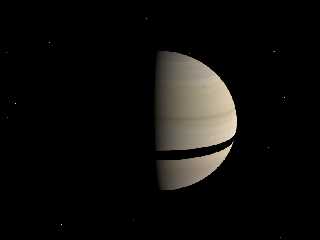
|
 |
|  |
|  |
|
 |
|
 |
|  |
|  |
|
 |
> > Sorry, I did a poor reading, and for the images I assumed too
> quickly your
> > problem was just the ultra-bright media... trying with your code on
> the last
> > message, I see that using extinction 0 gives the effect you are
> looking for.
>
> Yes, that's quite logical... I tried it, and it at least yielded roughly
> the result I want to achieve in the long run! Thank you for the tip...
> perhaps I'll up the extinction value to, let's say, 0.1 or 0.15, as the
> unlit side is of course somewhat darker than the lit side, irrespective
> of light filtering through...
Just for completeness' sake: From a theoretical point of view, the
"extinction" parameter is no good for your application, as it only
accounts for light that fails to be transmitted due to being scattered
away. As a consequence, only the scattered colors are attenuated
accordingly.
This is good for modelling media in which the scattering is primarily
due to diffraction or other interference effects (i.e. very small
particles, like molecules or very fine dust), but does not properly
model media containing larger objects in which the scattering is
primarily due to reflection, as in that case all wavelengths will be
obstructed, whether they are reflected (and therefore scattered) or not.
I guess in the case of the Saturn rings, reflection will be the primary
scattering effect, so it should be modeled using...
- an absorbing media to account for the shadowing effect
- a scattering media to account for the reflected light
The scattering media, in this case, should indeed have "extinction 0",
as the extinction component is already accounted for by the absorbing media.
Christoph
Post a reply to this message
|
 |
|  |
|  |
|
 |
|
 |
|  |
|
 |




![]()